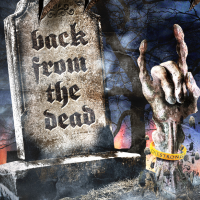Big Banks Back to Old Tricks Bundling Loans and Mortgages for Investments
 (graphic: Spinal Tap)
(graphic: Spinal Tap)
Proving that those who are not punished for their misdeeds are allowed to repeat them, the Wall Street banks that created and sold risky combinations of mortgages and loans during the pre-2008 boom—and crashed the world economy with them—are doing exactly the same thing again. Once again, financial products with obscure, complex-sounding names like “collateralized debt obligations” and “securitized mortgage instruments,” are being sold by Wall Street to people on Main Street.
The ominous return from the dead of these investments, also called structured financial products, has largely evaded new regulations meant to avert another crisis, prompting concern from financial industry observers. Manus Clancy, managing director at commercial real estate research firm Trepp, worries that “All of this seems like a fairly quick round trip. You are seeing a fair number of sins being forgiven.”
And the sinners who committed those sins are acting like they've been forgiven as well. “The players in the business are generally the same as they were before,” noted Tad Philipp, a commercial real estate analyst at Moody’s. “Because it’s the old players, they know how to push the boundaries.”
Wall Street is certainly pushing boundaries on securitized commercial mortgage-backed securities, in which a pool of commercial mortgages are mixed together into bonds, ranked by varying levels of risk. So far in 2013, banks have issued $33.5 billion in such bonds, slightly more than they did in early 2005. Before the 2008 crash, 57% of the outstanding money in such securities was in high-risk interest-only loans, a number that fell hard and fast, to just 11% two years ago. Today, that number has more than tripled to 34%.
Even faster to revive have been collateralized loan obligations, which are pools of loans given to companies with junk ratings. In the first quarter of 2013, banks issued about $26 billion of them—more than in the same period of the last boom year of 2007. Demand has been so strong that banks have started to loosen underwriting standards on the underlying loans and bonds, prompting the Federal Reserve to warn last month that “prudent underwriting practices have deteriorated.”
Those willing to learn from history will recall that securitization—the bundling of many loans into one investment—proved dangerous during the real estate bubble because when the bubble burst, investors learned that the complexity of the instruments had obscured their real risks, leading to unexpected losses by those investors, chaos in the financial system and the Great Recession. They will also recall that those who created these “shoddy deals” and then defrauded their investors escaped wealthy but largely unpunished, and are still working on Wall Street today.
-Matt Bewig
To Learn More:
Wall St. Redux: Arcane Names Hiding Big Risk (by Nathaniel Popper, New York Times)
SEC Tricks Judge to Help Citigroup (by Noel Brinkerhoff and David Wallechinsky, AllGov)
Why No Prison for Banksters Who Caused Financial Crisis…Yet? (by David Wallechinsky and Noel Brinkerhoff, AllGov)
- Top Stories
- Unusual News
- Where is the Money Going?
- Controversies
- U.S. and the World
- Appointments and Resignations
- Latest News
- Musk and Trump Fire Members of Congress
- Trump Calls for Violent Street Demonstrations Against Himself
- Trump Changes Name of Republican Party
- The 2024 Election By the Numbers
- Bashar al-Assad—The Fall of a Rabid AntiSemite






Comments